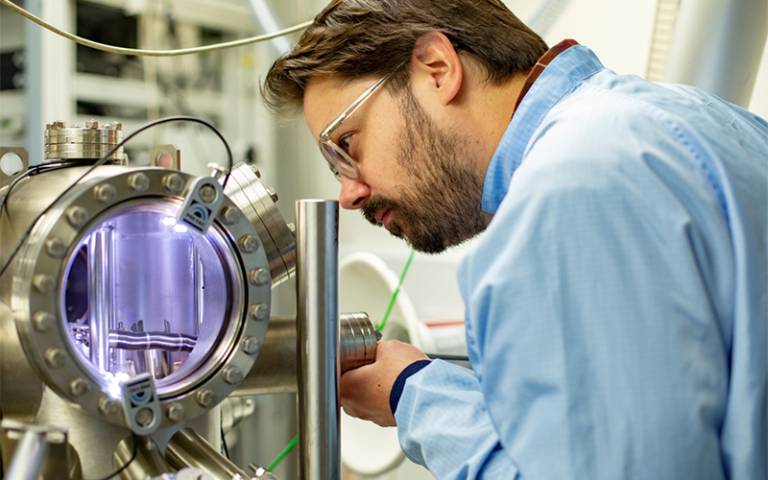‘Near perfect’ control of single atoms is major advance towards quantum computing
27 March 2024
A new fabrication process that could be used to build a quantum computer achieves an almost zero failure rate and has the potential to be scaled up, according to new research from engineers and physicists at UCL.

The study, published in Advanced Materials, describes the first successful attempt to reliably position single atoms in an array since the idea was first proposed 25 years ago. The near 100% precision and scalability of the approach raises the possibility of building a quantum computer capable of tackling the world’s most complex problems – though substantial engineering challenges still need to be overcome to realise that ambition.
Theoretically, quantum computing has the potential to solve complex problems that ‘classical’ binary, transistor-based computers will never be able to tackle. One way the gates in a universal quantum computer, known as qubits (quantum bits), can be created is from single atoms placed in silicon, cooled to extremely low temperatures to keep their quantum properties stable. They can then be manipulated with electrical and magnetic signals to process information, in much the same way that a binary transistor in a classical computer is manipulated to output a zero or a one.
This allows the computer to harness the power of quantum mechanics, the deep laws of physics that determine how the universe works. This includes phenomena such as superposition, or the ability of qubits to be in many different arrangements at the same time, and quantum entanglement, which is the ability of qubits to be inextricably linked.
These features mean complex problems can be represented in new ways. For a problem with an exceptionally large number of possible outcomes, a quantum computer is able to consider the possibilities simultaneously, rather than one at a time like a normal computer would – which would take today’s best supercomputer millions of years to process.
Various approaches to building a quantum computer are underway, but none have yet managed to reach the scale and low error rates required.
One approach to building a quantum computer is to precisely position individual ‘impurity’ atoms in a silicon crystal, which allows manipulation of their quantum properties to form qubits. One of the benefits of this approach is that it has inherently low qubit error rates and is underpinned by scalable silicon microelectronics technologies. The standard approach uses phosphorus as the impurity atom, but because single phosphorus atoms can only be positioned with a 70% success rate, this system remains some way off from the near-zero failure rate that is required to build a quantum computer.
In this study, researchers at UCL hypothesised that arsenic might be a better material than phosphorus to achieve the low failure rate needed to build a quantum computer.
They used a microscope capable of identifying and manipulating single atoms, similar to the needle on a vinyl record player, to precisely insert arsenic atoms into a silicon crystal. They then repeated this process to build a 2x2 array of single arsenic atoms, ready to become qubits.
Dr Taylor Stock, first author of the study from UCL Electronic & Electrical Engineering, said: “The most advanced quantum computing systems in development are still grappling with the twin problems of how to mitigate qubit error rates and how to scale up the number of qubits.
“Reliable, atomically-precise fabrication could be used to build a scalable quantum computer in silicon. The prevailing view was that single-atom fabrication using arsenic would suffer the same problems as phosphorus. But based on our calculations, we realised that single arsenic atoms might be placed more reliably than phosphorus, and we’ve been able to do this successfully. We’ve been conservative in estimating that we can place atoms with 97% accuracy, but we are confident that this can be increased to 100% in the near future.”
At the moment, the method developed in the study requires each atom to be positioned by hand one at a time, which takes several minutes. Theoretically this process can be repeated indefinitely, but in practical terms it will be necessary to automate and industrialise the process in order to build a universal quantum computer – which means creating arrays of millions, tens of millions or even billions of qubits.
The authors say that the silicon semiconductor industry, currently worth around $550 billion, should be able to contribute to advancing the field, as arsenic and silicon are both commonly used in the construction of semiconductors for classical computing. The approach developed in this study is expected to be highly compatible with current semiconductor processing and could hopefully be integrated once engineering challenges have been addressed.
Professor Neil Curson, senior author of the study from UCL Electronic & Electrical Engineering, said: “The ability to place atoms in silicon with near perfect precision and in a way that we can scale up is a huge milestone for the field of quantum computing, the first time that we’ve demonstrated a way of achieving the accuracy and scale required.
“We now have a huge engineering challenge ahead to be able to do this more quickly and easily – but this is the first time that I’ve felt certain that a universal quantum computer can be built.”
Links
- Dr Taylor Stock’s academic profile
- Professor Neil Curson's academic profile
- UCL Electronic & Electrical Engineering
- UCL Faculty of Engineering
- London Centre for Nanotechnology
- UCL Physics & Astronomy
- UCL Faculty of Mathematical & Physical Sciences
Image
- Dr Taylor Stock loading a sample into the scanning tunnelling microscope (STM), used to perform atomic scale fabrication. Credit: Agnese Abrusci/UCL.
Media contact
Matt Midgley
Email: m.midgley [at] ucl.ac.uk
 Close
Close

